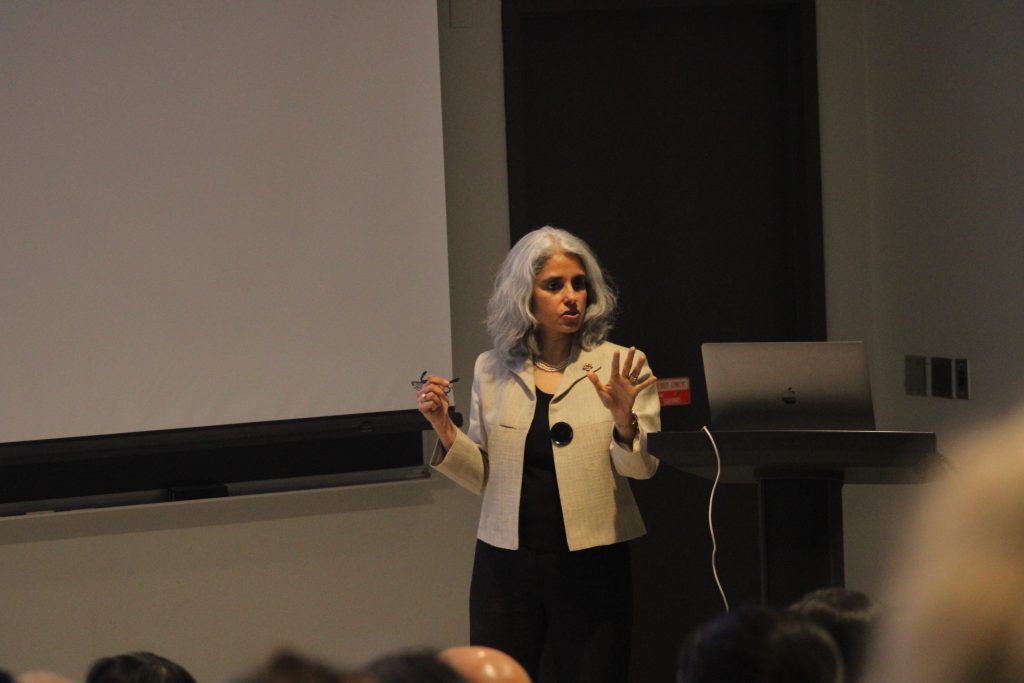Neha Khanna, a professor of economics at Binghamton University, delivered a talk on the intersection of race, environmental justice and redlining on Tuesday.
The lecture, titled “Race, Place, and Pollution: Redlining, Kinship, and Environmental Justice,” was part of the annual Harpur College Dean’s Distinguished Lecture series, which began in 1998 and offers faculty the ability to showcase their research. Previous lectures have included presentations on Judaic studies, art history and political science.
The event was co-sponsored by the BU chapter of United University Professions, a union for faculty and professional staff at institutions of higher education. Brendan McGovern, the chapter’s president and the program coordinator in the Geography Department, delivered opening remarks.
“Dr. Neha Khanna’s work goes beyond measuring environmental harms,” McGovern said. “It asks the deeper questions about how race, history and place determine who is burdened by pollution and why. It challenges us to see the ways systemic injustice is reproduced, even under the guise of progress. In many ways, her scholarship reminds us that education and research are not just academic pursuits. They are acts of public service and truth-telling.”
Khanna, the winner of the 2024 Lois B. DeFleur Faculty Prize for Academic Achievement, centered her talk on disparities in pollution levels between non-Hispanic white neighborhoods and historically redlined neighborhoods. Redlining was a discriminatory practice where financial services, like mortgages, were denied in often predominantly nonwhite neighborhoods. She cited studies that found these historically redlined neighborhoods were hotter and had worse air quality.
She said kinship was closely tied to environmental outcomes, using the sociological concept of in-group favoritism to explain why more diverse communities were less likely to invest in public goods that could benefit others outside their group and why more diverse neighborhoods had lower investment in public goods. According to Khanna, public goods include environmental quality.
“When we talk about investment in public amenities, that competition for resources becomes important,” Khanna said. “If there is, how much you compete and how many groups are competing, that fills out those availability of resources.”
To gauge kinship in her economic model, Khanna used quantitative methods to measure industry concentration, ethnic diversity and inequality.
Her research, based on a survey of 20,000 people provided by the National Institutes of Health, found that most who identified as people of color lived predominantly in racially and ethnically diverse neighborhoods, and those who identified as white tended to live in homogeneous neighborhoods. Her findings showed that the neighborhoods with the highest pollution were largely nonwhite in historically redlined areas.
“No matter which pollutant I look at, redlining is very strongly correlated with contemporary levels of pollution, no matter whether they’re regulated pollutants, unregulated pollutants, chemical and nonchemical, which is important,” Khanna said. “It is important, it is explaining that the areas that are redlined have higher levels of pollution, and these are not small numbers by the way.”
A study published last January found that historically redlined neighborhoods across California experienced worse environmental quality than other communities. Another study published by the American Chemical Society found that redlining was associated with disparities in present-day air pollution.
“To me, sustainability is not just ecological sustainability, it’s social sustainability,” Khanna said to Pipe Dream. “And if we forget this fundamental idea of equity, it doesn’t matter how great the solution is. If the if the losers are always the losers and the winners are always the winners, that cannot be a sustainable solution, because people are going to ultimately rise up.”



